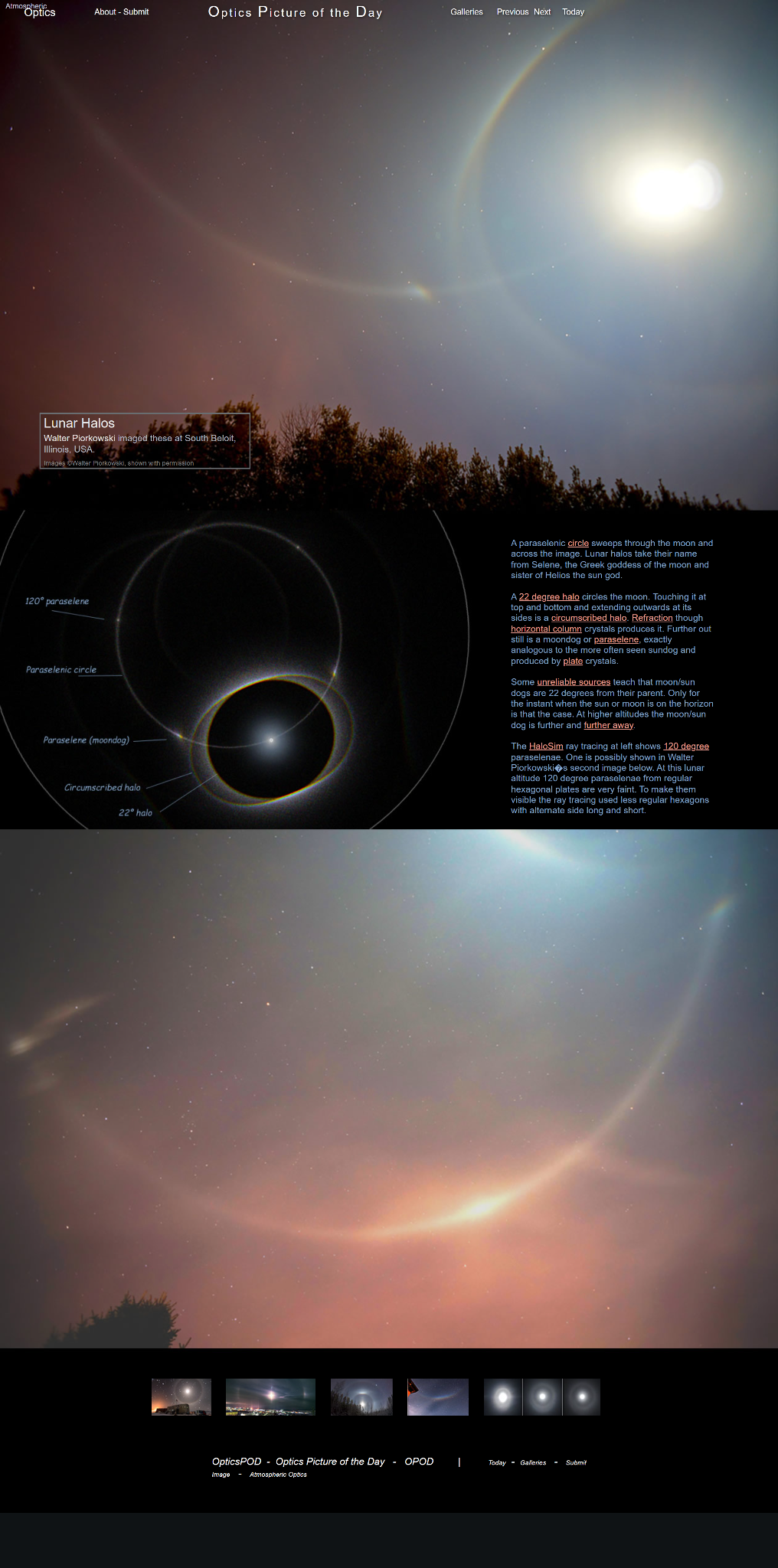Lunar Halos, Illinois - OPOD
Lunar Halos: A Phenomenon of Light and Beauty
Lunar halos, a mesmerizing atmospheric optical phenomenon, have captivated observers for centuries. These ethereal rings of light encircle the moon, creating a celestial spectacle that inspires awe and wonder. In this article, we will delve deeper into the intricacies of lunar halos, exploring their formation, characteristics, and the factors that contribute to their visual splendor.
The Origins of Lunar Halos
The term "lunar halo" derives from the Greek goddess Selene, who personified the moon in ancient mythology. These enchanting displays of light are caused by the refraction and reflection of moonlight through ice crystals suspended in the Earth's atmosphere. As the moon's rays encounter these tiny ice particles, they bend and scatter, giving rise to the stunning halo effect.
Unveiling the Components
A lunar halo typically consists of three main components:
-
22-Degree Halo: The most prominent feature, this circular halo encompasses the moon with a radius of approximately 22 degrees. It occurs due to the refraction of moonlight through hexagonal ice crystals.
-
Circumscribed Halo: Extending outward from the 22-degree halo, the circumscribed halo touches the top and bottom of the moon while extending horizontally on either side. This halo is formed by refraction through horizontal column crystals.
-
Moondogs or Paraselenae: Situated further out from the circumscribed halo, moondogs are analogous to sundogs and are produced by plate crystals. These bright spots often appear at an angle of 22 degrees or more from their parent source.
The Misconception of Moon/Sun Dogs
Contrary to some misconceptions, moon/sun dogs are not always located exactly 22 degrees away from their celestial counterpart. This alignment only occurs when the sun or moon is on the horizon. As their altitude increases, the distance between the moon/sun dog and its parent source expands.
The Enigmatic 120-Degree Paraselenae
An intriguing aspect of lunar halos is the presence of 120-degree paraselenae, which are faint rings encircling the moon. These elusive features are generated by regular hexagonal ice plates, although they are barely visible at certain lunar altitudes. To enhance their visibility, ray tracing techniques are employed, utilizing irregular hexagons with alternating long and short sides.
Exploring Lunar Halos in Illinois
The images captured by Walter Piorkowski in South Beloit, Illinois, provide a stunning glimpse into the enchanting world of lunar halos. These photographs showcase the intricate details of the halos and offer a visual feast for those fascinated by atmospheric optics.
A Word of Caution
It is important to note that the automatic conversion of this article may have altered its intended appearance. For the original version of this content, please refer to the provided link.
In conclusion, lunar halos are a captivating phenomenon that adds a touch of magic to our night skies. Understanding their formation and components allows us to appreciate the intricate beauty of these celestial displays. So, the next time you find yourself gazing at the moon, keep an eye out for the mesmerizing halo that encircles it, connecting us to the wonders of the universe.

Lunar Halos
Walter Piorkowski imaged these at South Beloit, Illinois, USA.
Images ©Walter Piorkowski, shown with permission
A paraselenic circle sweeps through the moon and across the image. Lunar halos take their name from Selene, the Greek goddess of the moon and sister of Helios the sun god.
A 22 degree halo circles the moon. Touching it at top and bottom and extending outwards at its sides is a circumscribed halo. Refraction though horizontal column crystals produces it. Further out still is a moondog or paraselene, exactly analogous to the more often seen sundog and produced by plate crystals.
Some unreliable sources teach that moon/sun dogs are 22 degrees from their parent. Only for the instant when the sun or moon is on the horizon is that the case. At higher altitudes the moon/sun dog is further and further away.
The HaloSim ray tracing at left shows 120 degree paraselenae. One is possibly shown in Walter Piorkowski�s second image below. At this lunar altitude 120 degree paraselenae from regular hexagonal plates are very faint. To make them visible the ray tracing used less regular hexagons with alternate side long and short.

Note: this article has been automatically converted from the old site and may not appear as intended. You can find the original article here.
Reference Atmospheric Optics
If you use any of the definitions, information, or data presented on Atmospheric Optics, please copy the link or reference below to properly credit us as the reference source. Thank you!
-
<a href="https://atoptics.co.uk/blog/lunar-halos-illinois-opod/">Lunar Halos, Illinois - OPOD</a>
-
"Lunar Halos, Illinois - OPOD". Atmospheric Optics. Accessed on November 21, 2024. https://atoptics.co.uk/blog/lunar-halos-illinois-opod/.
-
"Lunar Halos, Illinois - OPOD". Atmospheric Optics, https://atoptics.co.uk/blog/lunar-halos-illinois-opod/. Accessed 21 November, 2024
-
Lunar Halos, Illinois - OPOD. Atmospheric Optics. Retrieved from https://atoptics.co.uk/blog/lunar-halos-illinois-opod/.